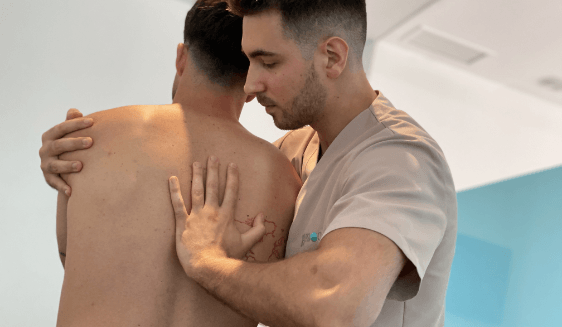
Osteopathy focuses on identifying hypomobility in the body.
With an extensive knowledge of human anatomy, physiology, and biomechanics as its starting point, osteopathy is the science that led to the development of a holistic method focused on treating the patient rather than the pathology. Its aim is not only to eradicate the symptoms, but also to identify and eliminate their source. Thus, osteopathy focuses on identifying hypomobility in the body, that is, joint dysfunctions or areas of the body that are not moving as they should due to a significant degree of limitation or joint blockage.
In short, these are manual techniques that go beyond curing a simple pain: the aim is for the patient to regain organic balance.
What are the origins of osteopathy?
The origins of osteopathy can be traced back to the United States of the late nineteenth century, to a doctor and surgeon named Andrew Taylor Still. His work led him to discover and demonstrate relationships between the musculoskeletal system and other organ systems, and, during the period 1870 – 1874, Still began the first clinical osteopathic work. In June of 1874, osteopathy was officially recognized as a medical discipline.

1. Structural osteopathy: which involves the application of techniques focused on anatomical structures such as muscles, joints, and ligaments using high velocity/low amplitude manipulations; functional or myofascial techniques; pumping techniques; joint techniques, etc.
2. Visceral osteopathy: which involves the application of techniques focused on the fascia and ligaments that support and hold the body’s organs together. Two good examples of visceral pathologies that can be treated with osteopathy are hiatal hernia and constipation.
3. Cranial osteopathy: which involves the application of techniques focused on the cranial sutures (joints in the skull) and intraosseous membranes. The aim is to restore mobility/plasticity to the skull and sacrum in order to restore the cranio-sacral respiratory rhythm. The skull and the sacrum are closely related via the dura mater (outermost meningeal layer), so tensions within this membrane can alter the cranio-sacral rhythm and cause problems in the rest of the body.

- Spinal pain: cervical, dorsal, lumbar
- Pains or symptoms involving the head or face: headaches and migraines, eye pain, dizziness, facial neuralgia, etc.
- Pain in the upper limbs: shoulder, elbow, forearm or hand, cervicobrachial neuralgia.
- Chest, abdominal, or pelvic pain
- Lower limb pains: hip, knee, ankle or foot: sciatica, cruralgia (thigh pain), tendonitis, sprains.
Frequently asked questions - Osteopathy
What is osteopathy?
Osteopathy is a manual therapy that focuses on diagnosing and treating dysfunctions of the musculoskeletal system. It is based on the premise that the body has the ability to self-heal and that, through manual techniques, balance and proper function of tissues and organs can be restored.
What conditions does osteopathy treat?
Osteopathy addresses a wide range of conditions, including:
- Back and neck pain.
- Sports injuries.
- Headaches and migraines.
- Joint problems.
- Digestive disorders.
- Postural imbalances.
By treating the body as a whole, osteopathy aims to identify and correct the underlying causes of these conditions.
How is osteopathy different from physiotherapy?
While both disciplines share similar goals, osteopathy focuses on a holistic approach to the body, primarily using manual techniques to restore balance and function. Physiotherapy, on the other hand, is more focused on treating specific symptoms through therapeutic exercises, electrotherapy, and other modalities, with an emphasis on physical rehabilitation and functional recovery.
Is osteopathy safe?
Yes, osteopathy is considered safe when performed by a qualified professional. At Fisioclínica La Herradura, we have years of experience and ongoing training in the field, ensuring safe and effective treatments for our patients.
How many osteopathy sessions are necessary?
The number of sessions depends on the condition and the individual response of each patient. During the first visit, a comprehensive evaluation is carried out to determine the appropriate treatment plan. Some conditions may require only one session, while others may need several to achieve optimal results.
Is osteopathy suitable for children?
Yes, osteopathy can be beneficial for children of all ages. It is tailored to the individual needs of the child and can help with conditions such as feeding difficulties, colic, torticollis, digestive disorders, and sports injuries, among others.
What will I feel after an osteopathy session?
After a session, it is common to experience tiredness, a headache, or temporary discomfort in the treated areas. These symptoms are usually part of the body’s self-healing process and subside quickly. It is advisable to rest and avoid intense physical activities after the session.
